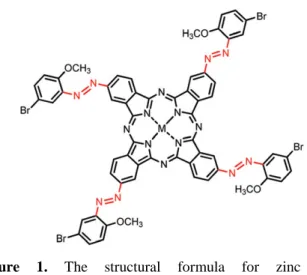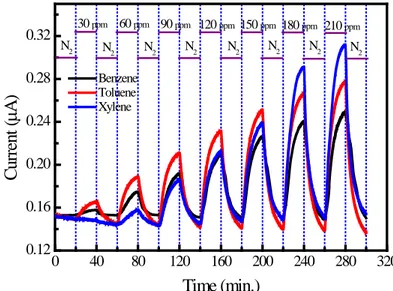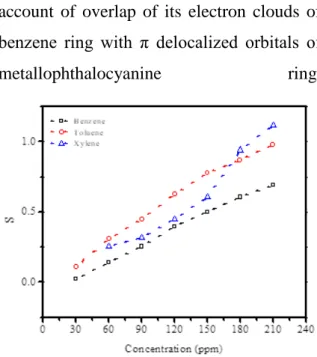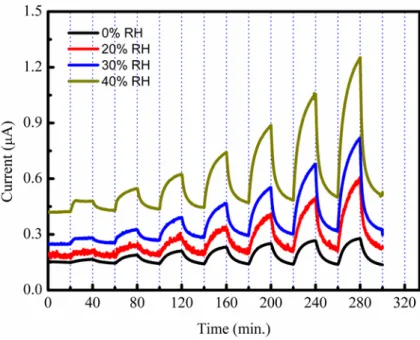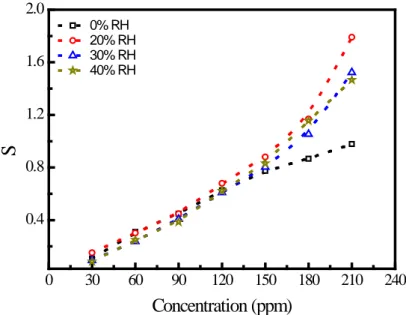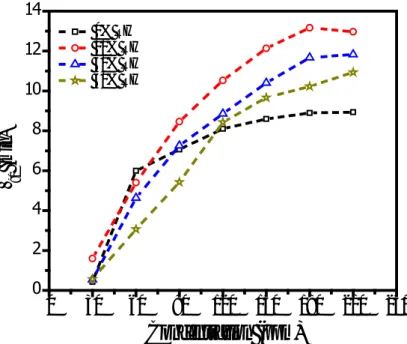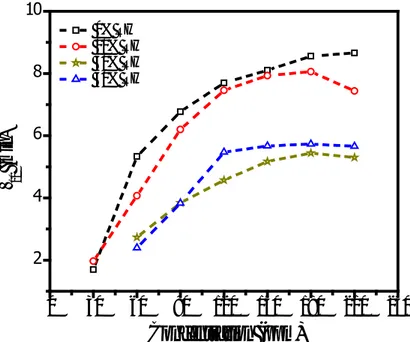136
Kabul (Accepted) :04/09/2019
Room Temperature BTX Sensor Based on Zinc Phthalocyanine Thin Film
Asuman AŞIKOĞLU BOZKURT
Yıldız Technical University, Faculty of Science, Department of Physics, İstanbul
*asikoglu@yildiz.edu.tr
Abstract: This study deals with comparing interaction mechanisms of 2(3), 9(10), 16(17), 23(24)-Tetra-((5-bromo-2-methoxyphenyl)diazenyl) phthalocyaninatozinc(II) (zinc phthalocyanine) thin film with versatile chemical vapours: stable and electron donating aromatic vapours namely; benzene, toluene and xylene. The variation in electrical conductivity of zinc phthalocyanine is used as an indicator of the BTX- zinc phthalocyanine interactions. It was found that, unexpectedly, the exposure of the sensor surface to BTX vapors cause an increase in sensor current. It was observed for low concentrations of BTX vapours that, zinc phthalocyanine based sensor exhibits maximum and minimum sensitivities towards toluene and xylene vapors, respectively. However, the maximum and minimum sensitivities of the sensor gradually changes from xylene to benzene for high concentrations of BTX vapors. These findings was concluded in the framework of reaction activation energy and the presence of some water dissociated species, such as H+ or OH−.
Keywords: BTX sensing, phthalocyanine, response time, relative humidity
Oda Sıcaklığında Çinko Ftalosiyaninin BTX Gazlarına Duyarlılığı
Öz: Bu çalışmada; benzen, toluen ve ksilen gibi elektron veren stabil aromatik buharların 2(3), 9(10), 16(17), 23(24)-Tetra-((5-bromo-2-methoxyphenyl)diazenyl) phthalocyaninatozinc(II) (Çinko ftalosiyanine) ince film mekanizması ile etkileşimi karşılaştırılmıştır. Çinko ftalosiyanine’in elektriksel iletkenlikteki değişimi, BTX- çinko ftalosiyanine etkileşiminin bir göstergesi olarak kullanılır. Sensör yüzeyinin BTX buharlarına maruz kalması, sensör akımında beklenmedik bir artışa neden olmaktadır. Düşük BTX buhar konsantrasyonlarında, çinko ftalosiyanine sensörü toluen buharlarına maksimum, ksilen buharına minimum hassasiyet göstermektedir. Ancak, yüksek BTX buhar konsantrsanyonlarında ksilen için maksimum, benzene için minimum duyarlılık görülmüştür. Bu bulgular, H+ ve OH− gibi bazı ayrışmış su moleküllerinin varlığı ve reaksiyon aktivasyon
enerjisinin sonucudur.
Anahtar Kelimeler: BTX algılama, ftalosiyanine, cevap süresi, bağıl nem
1. Introduction
Aromatic hydrocarbons such as benzene, toluene and xylene represent one of the most important class of air pollutant, not only due to their wide spread use in various fields, but also because of their carcinogenicity even at trace levels (Bearzotti et al., 2017; Im et al., 2016; Ueno et al., 2002). According to the Occupational
Safety and Health Administration standard the permissible exposure limits of benzene, toluene, and xylenes is 1, 200, and 100 ppm in the workplace, respectively (OSHA standard). Therefore, development of highly sensitive, low power and cost BTX sensing devices operating at room temperature is an important issue for public health and environmental protection. A number of
Bozkurt, Ekim (2019) 45(2):136-148
137 sensing materials including pentacene (Bearzotti et al., 2017), mesoporous silica (OSHA standard), yttrium-doped lithium iron phosphate (Nizamidin, 2012), polyacrylate resin (Kadir, 2009), and nano-sized γ-Al2O3/PtO2composite (Sun, 2014).
The BTX sensing performance of iron tetraphenyl porphyrin and cobalt tetraphenyl porphyrin functionalized single walled carbon nanotubes were investigated by Rushi et al. (2014). The observed high sensitivity to toluene vapor with both sensors was attributed to the presence of – CH3 group in toluene. The effect of the Pt,
Pd and Au decoration on the BTX sensing properties of SnO2 nanowires were
examined by Kim et al. (2016). It was reported that Pt, Pd and Au decorated SnO2
nanowires exhibit enhanced sensing performance towards C7H8, C6H6, and CO
gases at 400°C. Recently, Geetha et al., (2011) have prepared TiO2 nanoparticle
decorated GaN nanowires for the detection of BTX gases. The sensing experiments showed that there was no significant response to VOC vapours investigated with GaN based sensor. On the other hand, the TiO2 nanoparticle decorated GaN nanowire
based sensor exhibited a strong response to VOCs. Au nanoparticle loaded mono disperse α-MoO3 hollow spheres was used
as sensing element for the detection of BTX gases by Sui et al. (2017). It was found that Au nanoparticle loading leads to a decrease
in optimal working temperature of the sensor. It was also reported that the BTX sensing performance of the α-MoO3 hollow
spheres was improved significantly by Au nanoparticle functionalization. Although metal-oxide based sensors have some advantages such as low production cost, and fast response time, their relatively low selectivity towards BTX gases and high operating temperature (sometimes is high >300°C) are the main drawbacks in the use of metal-oxide semiconductor as sensing element. High operating temperature causes a shift of sensor signal in time and low stability over a long period (Mirzaei et al., 2018).
More recently, organic semiconductor materials have attracted more attention as cost effective, highly sensitive and stable sensing element for BTX detection. Phthalocyanines (Pcs) and their derivatives are the best among other organic compounds due to their excellent chemical and thermal stability, and tunable sensing performance. To date, some phthalocyanine compounds have been successfully explored to fabricating toluene (Şahin et al., 2015) and xylene (Altın et al., 2015) sensors. However, there are very limited studies in literature on the BTX sensing with phthalocyanine thin film. The aim of the present work is to investigate the low level BTX sensing performance of 2(3),9(10),16(17),23(24)-Tetra-((5-bromo-2-methoxyphenyl)
138 diazenyl) phthalocyaninatozinc (II) thin film. This study also highlights the effect of the relative humidity on the BTX sensing behavior of the compound.
2. Material and Methods
For BTX sensing experiments, photolitographically patterned tin inter digital micro electrode (IME) arrays with 100 µm electrode width and 100 µm spacing
was used as transducer.
2(3),9(10),16(17),23(24)-Tetra-((5-bromo-2-methoxyphenyl) diazenyl) phthalocyaninatozinc (II) (zinc
phthalocyanine) was chosen as sensing element and the synthesis details of sensing element can be found elsewhere (Yüzüak et al., 2015). The structural formula of the sensing element is shown in Figure 1. Compound zinc phthalocyanine was synthesized as follows; a mixture of 0.4 mmol 4-((5-Bromo-2-methoxyphenyl)diazenyl)phthalonitrile and 0.5 mmol Zn(CH3COO)2·2H2O was
transferred into a reaction tube. 0.30 mL DMF and 0.05 mL DBU as catalysts were added and then the reaction mixture was heated to 350 °C. After 10 minutes, the reaction mixture cooled down to room temperature and was precipitated by adding acetic acid.
Figure 1. The structural formula for zinc phthalocyanine
The crude product was filtered and washed with an aqueous acetic acid solution and purified by column chromatography. Because of good solubility of the compound zinc phthalocyanine in tetrahydrofouran (THF), thin film of zinc phthalocyanine was formed by spin coating 3×10-3 M THF solution of zinc phthalocyanine. In order to be sure that all the solvent in the film was removed, film of the compound zinc phthalocyanine was thermally treated at 110 ºC for 30 min. During the BTX sensing tests, dry nitrogen with a purity level of 99.99% was used as carrier gas and the variation of the sensor current at constant dc bias of 0.5 V was selected as sensor signal as an indicator of the BTX sensitivity. Desired concentrations of the BTX gases were obtained from liquid phase of the aromatic hydrocarbons by bubbling of dry nitrogen gas and the final concentration of target vapors were obtained by mixing the dry nitrogen with the BTX vapor using
Bozkurt, Ekim (2019) 45(2):136-148
139 computer driven mass flow controllers (Alicat Scientific, Inc.). A typical BTX sensing experiment consisted of exposure to various concentrations of test gases between 30 and 210 ppm and subsequent purging with carrier gas, dry nitrogen in our case. In order to clarify the effect of relative humidity (RH) on the BTX sensing properties of zinc phthalocyanine, the level of the RH during BTX sensing experiments was varied between 0% and 40%
3. Results and Discussion
BTX sensing test experiment was carried out on the 2(3),9(10),16(17),23(24)-Tetra-((5-bromo-2-methoxyphenyl)
diazenyl) phthalocyaninatozinc (II) thin film at 0% relative humidity condition before the relative humidity dependent measurements. Figure 2 shows the variations of zinc phthalocyanine based sensor current with BTX concentrations in which gas injection and purging stages have been clearly marked. At the initial stage of BTX exposure, a fast increase in sensor current and a drift to the steady state value with increasing exposure time can be seen clearly from the Figure 2. This figure also indicates that the adsorption of the BTX molecules onto the zinc phthalocyanine is a reversible processes. As is clear from the Figure 2 that an unexpected increase in sensor current was observed when the sensor surface interact with weakly electron donating toluene and
xylene as well as the stable aromatic vapour benzene (which is neither reducing nor oxidizing). It is also clear that sensitivity of the sensor shows BTX concentration dependence. For low concentrations of BTX vapours, the sensor exhibits maximum and minimum sensitivities towards toluene and xylene vapors, respectively. However, the maximum and minimum sensitivities of the sensor gradually changes from xylene to benzene for high concentrations of BTX vapors. It was confirmed by photoelectron spectroscopy and photoionization studies that (Koch and Grobman, 1977; Pope, 1972) Pcs exhibit p-type conduction character. In contrary to expectations, as is clear from response-recovery behavior presented in Figure 2, interaction between the BTX vapors and Pc unit result in an increase in sensor current. In addition, it should be mentioned here that the main difference between benzene, toluene and xylene is the presence and the position of methyl groups on the aromatic ring. Increase in sensor current clearly shows that electron transfer from the n-type Pc unit to the BTX molecule took place during interaction. Understanding the exact nature of these interactions is a key challenge in making volatile organic compound vapour sensors. It is generally accepted that the adsorbed oxygen molecules on the Pc surface plays crucial role in the conduction processes. The overall conduction in a Pc based sensor element,
140 which will determine the sensor response, is determined by the surface reactions, the resulting charge transfer processes with the
underlying and the transport mechanism from one electrode to the other through the sensing layer. 0 40 80 120 160 200 240 280 320 0.12 0.16 0.20 0.24 0.28 0.32 Benzene Toluene Xylene C ur re nt ( µA ) Time (min.) N2 N2 N2 N2 N2 N2 N2 210 ppm 180 ppm 150 ppm 120 ppm 90 ppm 60 ppm 30 ppm N2
Figure 2. Room temperature response-recovery characteristics of the zinc phthalocyanine based sensor to various concentrations of BTX vapors
It means that the adsorbed O2 on the
sensing layer result in the production of O2−
and O− at the surface. It is also considered that when these surface oxygen ions interact with electron donating gases like toluene and xylene release electrons to the Pc molecule and thus cause a decrease in its conductivity. As mentioned above, in the contrary to expectations, when the sensor surface interacts with the reducing gas as well as the stable aromatic vapour such as benzene vapour the conductivity of the sensor increases. If the interaction between the
2(3),9(10),16(17),23(24)-Tetra-((5-bromo-2-methoxyphenyl) diazenyl) phthalocyaninatozinc (II) and the BTX
vapors have occurred on the phthalocyanine
core the conductivity of the film would have decreased. Instead of that, the opposite trend observed reveals that charge transfer interaction involve at least two mechanism; interaction with central metal ion and surrounding isoindole units of Pc and with substituent group. Our sensing results clearly shows that charge transfer interactions take place between the BTX molecules and substituent group. The sensing capability of the zinc phthalocyanine based sensor was compared with its sensitivity to BTX vapors. The concentration dependent BTX sensitivity of the sensor was presented in Figure 3. Here, the sensitivity (S) of the sensor was defined as
Bozkurt, Ekim (2019) 45(2):136-148 141 0 Ι 0 Ι − Ι = Ι = 0 I Δ S (1)
where ∆I is the changes in sensor current at a given concentration of BTX vapor, and I0 is baseline value of the sensor
current. As can be seen from the Figure 3 that the sensor sensitivity is an increasing function of target molecule concentrations for all aromatic vapours investigated. It is also clear from the Figure 3 that, the lowest sensitivity was observed to benzene molecules for all concentrations of the benzene. On the other hand, maximum sensitivity was obtained for toluene and xylene at low and high concentrations of the target molecules, respectively. This observations reveal that the charge transfer interaction between the Pc molecule and the BTX vapors depends on the presence of methyl groups on the aromatic ring. From the sensitivity results (Figure 3), we observed that sensitivity of the zinc phthalocyanine based sensor toward benzene vapours is more less or the same. The low sensitivity to benzene for all concentrations of target molecules can be attributed to the absence of methyl group on the benzene ring. On the other hand, toluene and xylene have one and two methyl groups, respectively, which facilitate the better adsorption of these gases on the Pc film. Although zinc has sufficient electron affinity to attract and bind with the electron clouds
of benzene vapours, which results in increase of its current, interaction mechanism of benzene vapours is on account of overlap of its electron clouds of benzene ring with π delocalized orbitals of
metallophthalocyanine ring.
Figure 3. Variation of the sensitivity with BTX concentration
It is well known that the interaction at the metal site is also governed by the chemical properties of the metal such as spin state and electronegativity. In conclusion, it is clear that the presence and the number of the methyl group on target molecules has a strong effect on the adsorption processes (Mirzaei et al., 2018; Shen et al., 2018).
In the present study, we also studied the influence of relative humidity (RH) on the BTX sensing performance using dry nitrogen with different humidity levels as a carrier gas. As a representative result, the variation of the zinc phthalocyanine based sensor current measured when exposed to toluene of varying concentrations in the presence of various levels of relative
142 humidity between 0% and 40% is depicted in Figure 4. When compared with 0% RH (dry atmosphere), the effect of the RH on both baseline current and the toluene sensitivity of the zinc phthalocyanine based sensor can be clearly seen from this figure. It is clear from the Figure 4 that RH has a strong effect on the baseline sensor current,
it increases with increasing RH level, but also high sensitivity to BTX vapors. It should be mentioned here that the same type of response-recovery behavior was also observed for other VOC vapors, benzene and xylene.
Figure 4. Effect of the RH on the toluene sensing characteristic of the sensor
In order to clarify the effect of the RH on the BTX sensing capability of the zinc phthalocyanine based sensor investigated, toluene sensing performance of the sensor was compared in terms of its sensitivity. Figure 5 shows toluene concentration dependence of the sensor under indicated RH conditions. A close investigation of the Figure 5 indicates that the RH has a negligible effect on the room temperature low concentration toluene sensitivity of the
zinc phthalocyanine based sensor. Also, we observe from Figure 5 that the sensitivity is increased with increase in concentration of toluene from 0.15 at 30 ppm to 1.80 at 210 ppm for zinc phthalocyanine thin film. On the other hand, it is also clear from the Figure 5 that the toluene sensitivity of the sensor increases with increasing RH level. Increasing toluene sensitivity with RH level suggest that pre-adsorbed water molecules facilitate toluene adsorption or behave as
Bozkurt, Ekim (2019) 45(2):136-148
143 adsorption site. The same type of RH dependence was observed for xylene vapors. Unlike toluene and xylene sensitivity, it was
observed that the benzene sensitivity of the sensor decreases with increasing RH level.
0 30 60 90 120 150 180 210 240 0.4 0.8 1.2 1.6 2.0 0% RH 20% RH 30% RH 40% RH
S
Concentration (ppm)Figure 5. Variation of the sensitivity with toluene concentrations at indicated RH
This suggests that when benzene was under humid conditions, competition between benzene and water vapor for adsorption on the surfaces of the sensor led to a lower sensor sensitivity. BTX sensing performance of the sensor was also compared in terms of response and recovery time, which are estimated from the measured response-recovery characteristics. As usual, response time (τ90) of a sensor is
defined as the time it takes the sensor response to reach 90% of its stable value. Likewise, recovery time (τ10) of a sensor is
defined as the time required in returning to 10% below its initial value under dry nitrogen atmosphere. The RH dependence of the response time for zinc phthalocyanine based sensor as function of toluene concentrations, as a representative result, is shown in Figure 6.
144 0 30 60 90 120 150 180 210 240 0 2 4 6 8 10 12 14 0% RH 20% RH 30% RH 40% RH τ 90 ( mi n)
Concentration (ppm)
Figure 6. Toluene concentration dependence of the response time
As is clear from the Figure 6 that the response time of sensor to toluene vapor is a function of the toluene concentration, it increases with increasing toluene concentration for all RH levels investigated. It is also clear from the same figure that the low concentration response time of the sensor exhibits RH independent behavior. On the other hand for high concentrations of toluene vapor, the response time of the sensor increases with increasing RH level. The observed RH and concentration dependence reveals that for zinc phthalocyanine based sensor, pour-vapour interaction becomes dominant over vapour-film surface resulting in swelling of thin film after high BTX vapour exposure (Ridhi et al., 2017). Therefore, the increase in response time with increase in BTX concentrations can be attributed to the
swelling of the film. It should be mentioned here that, in general, low concentration response time of the sensor is a decreasing function of the RH level. It decreases with increasing RH. On the other hand, the response time increases with increasing RH level for high concentration of BTX vapor. This observation can be attributed to the presence of some water dissociated species, such as H+ or OH−, because of the reduction in reaction activation energy. The effect of the BTX concentration on the recovery time of the sensor under various RH conditions were also investigated. Figure 7 shows the variation of the recovery time with toluene concentration at indicated RH levels for zinc phthalocyanine based sensor. It is clear from this figure that, likewise response time, the recovery time is also an increasing function of toluene concentration for all RH levels.
Bozkurt, Ekim (2019) 45(2):136-148 145 0 30 60 90 120 150 180 210 240 2 4 6 8 10 0% RH 20% RH 30% RH 40% RH τ 10 ( mi n )
Concentration (ppm)
Figure 7. Variation of the recovery time with toluene concentration at indicated RH levels
This might be due to the swelling effect of the BTX vapour adsorption on the film surface. As mentioned above, the interaction activation energy for BTX-film interactions decreases with increasing concentration due to the swelling effect. This reduction in reaction activation energy facilitates the desorption of the adsorbed molecules and thus recovery time of the sensor. A close investigation of the Figure 7 clearly indicates that the recovery time, in contrary to response time, decreases with the increase in RH level for all concentrations of the BTX vapors. This again suggests that the pre-sorbed water molecules affect the sensing behavior of the zinc phthalocyanine based sensor via the presence of some water dissociated species.
4. Conclusion
The selective detection of benzene, toluene and xylene vapours is challenging because of their quite toxic nature and wide spread usage in many industrial applications. On the other hand, because of the relatively low chemical reactivity of the BTX gases, the development highly sensitive resistive based sensor has a crucial importance. In this respect, the room temperature BTX sensing performance of the 2(3),9(10),16(17),23(24)-Tetra-((5-bromo-2-methoxyphenyl)diazenyl)
phthalocyaninatozinc (II) thin film was investigated. Present work demonstrates that the presence and the number of the – CH3
group in target molecules has a significant effect on the BTX sensitivity of the 2(3),9(10),16(17),23(24)-Tetra-((5-bromo-2-methoxyphenyl)diazenyl)
146 sensor. Swelling effect observed at higher vapour concentrations has been found to be more pronounced for zinc phthalocyanine thin film. This suggests that the choice of target molecules to sense is an important parameter for the development of zinc phthalocyanine based sensing element. For BTX sensing, zinc phthalocyanine based
thin film may be considered as a better BTX sensing element.
Acknowledgement
This work has been supported by Yıldız Technical University Research Projects Coordination under project no 2015-01-01-GEP01.
References
1
Altın Ş, Dumludağ F, Oruç Ç, Altındal A (2015). Influence of humidity on kinetics of 2
xylene adsorption onto ball-type hexanuclear metallophthalocyanine thin film. 3
Microelectronic Engineering 134: 7–13. 4
Bearzotti A, Macagnano A, Papa P, Venditti I, Zampetti E (2017). A study of a QCM 5
sensor based on pentacene for the detection of BTXvapors in air. Sensors and 6
Actuators 240: 1160–1164. 7
Geetha SA, Abhishek M, Albert VD, Vladimir PO, Kris AB, Norman AS, Mulpuri VR 8
(2011). Highly selective GaN-nanowire/TiO2-nanocluster hybrid sensors for
9
detection of benzene and related environment pollutants. Nanotechnology 22: 10
295503. 11
Im J, Sterner ES, Swager TM (2016). Integrated gas sensing system of SWCNT and 12
cellulose polymer concentrator for benzene, toluene, and xylenes. Sensors 16: 13
183. 14
Kadir R, Yimit A, Ablat H, Mahmut M, Itoh K (2009). Optical waveguide BTX gas 15
sensor based on polyacrylate resin thin film. Environmental Science and 16
Technology 43: 5113–5116. 17
Kim JH, Wu P, Kim HW, Kim SS (2016). Highly Selective Sensing of CO, C6H6, and 18
C7H8 gases by catalytic functionalization with metal nanoparticle. ACS Applied 19
Material Interfaces 8: 7173–7183. 20
Koch EE, Grobman WD (1977). Ultraviolet photoemission studies of phthalocyanines. 21
The Journal of Chemical Physics 67: 837–839. 22
Bozkurt, Ekim (2019) 45(2):136-148
147
Mirzaei A, Kim J, Kim HW, Kim SS (2018). Resistive-based gas sensors for detection 1
of benzene, tolueneand xylene (BTX) gases: A review. Journal of Physical 2
Chemistry C 6: 4342–4370. 3
Mirzaei A, Kim J, Kim HW, Kim SS (2018). Resistive-based gas sensors for detection 4
of benzene, toluene and xylene (BTX) gases: A review. Journal of Materials 5
Chemistry C 6: 4342–4370. 6
Nizamidin P, Yimit A, Nurulla I, Itoh K (2012). Optical waveguide BTX gas sensor 7
based on yttrium-doped lithium iron phosphate thin film. ISRN Spectroscopy 8
2012: 1–6. 9
Occupational Safety and Health Administration (OSHA Standard) 29 CFR 1910.1000. 10
Pope M (1962). Surface ionization energies of organic compounds: phthalocyanines. 11
The Journal of Chemical Physics 36: 2810–2811. 12
Ridhi R, Saini GSS, Tripathi SK (2017). Sensing of organic vapours by sulfonated 13
copper phthalocyanine salt thin films. Materials Focus 6: 386–393. 14
Rushi AD, Datta KP, Ghosh PS, Mulchandani A, Shirsat MD (2014). Selective 15
discrimination among benzene, toluene, and xylene: 497 probing 16
metalloporphyrin-functionalized single-walled carbon 498 nanotube-based field 17
effect transistors. The Journal of Physical Chemistry C 18: 24034–2404. 18
Şahin S, Altun S, Altındal A, Odabaş Z (2015). Synthesis of novel azo-bridged 19
phthalocyanines and their toluene vapour sensing properties. Sensors and 20
Actuators B 206: 601–608. 21
Shen Z, Zhang X, Ma X, Mi R, Chen Y, Ruan S (2018). The significant improvement 22
for BTX (benzene, toluene and xylene) sensing performance based on Au-23
decorated hierarchical ZnO porousrose-like architectures Z. Sensors and 24
Actuators B: Chemical 262: 86–94. 25
Sui L, Zhang X, Cheng X, Wang P, Xu Y, Gao S, Zhao H, Huo L (2017). Au-loaded 26
hierarchical MoO3 hollow spheres with enhanced gas-sensing performance for
27
the detection of BTX (Benzene, Toluene, And Xylene) and the sensing 28
mechanism. ACS Applied Material Interfaces 9(2): 1661–1670. 29
Sun Y, Cao X, Liu Y, Wang N, He R (2014). Research on benzene, toluene and 30
dimethyl benzene detection based on a cataluminescence sensor. Luminescence 31
29: 122–126. 32
148
detection of BTX mixture gas by a microfluidic device using a function of 2
nanosized pores of mesoporous silica adsorbent. Analytical Chemistry 74: 5257– 3
5262. 4
Yüzüak MM, Altun S, Altındal A, OdabaşZ (2015). Dielectric properties and electronic 5
absorption: a comparison of novel azo- and oxo-bridged phthalocyanines. 6
Dalton Transactions 44: 1397–1405. 7
